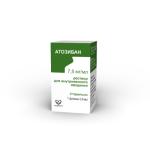Cabergoline
ТаблеткиDopamine receptor agonist

Indications
- Prevention of physiological lactation after childbirth
- Suppression of already established postpartum lactation
- Treatment of disorders associated with hyperprolactinemia, including amenorrhea, oligomenorrhea, anovulation, galactorrhea
- Prolactin-secreting pituitary adenomas (micro- and macroprolactinomas)
- Idiopathic hyperprolactinemia
- The syndrome of the "empty" Turkish saddle in combination with hyperprolactinemia
Contraindications
- Hypersensitivity to cabergoline or other components of the drug, as well as any ergot alkaloids
- Cardiac and respiratory disorders due to fibrotic changes in the lungs, pericardium, heart valves, or retroperitoneal space, or the presence of such conditions in the anamnesis
- During long-term therapy: anatomical signs of pathology of the valvular heart apparatus (such as thickening of the valve leaf, narrowing of the valve lumen, mixed pathology, narrowing and stenosis of the valve), confirmed by echocardiographic examination (EchoCG) performed at the beginning of therapy
- The risk of postpartum psychosis
- Breastfeeding period
- Children under 16 years of age (safety and efficacy of the drug have not been established)
- Lactose intolerance, lactase deficiency, glucose-galactose malabsorption
With caution
Like other ergot derivatives, cabergoline should be prescribed with caution for the following conditions and/or diseases:
- Arterial hypertension that develops during pregnancy, for example, preeclampsia or postpartum hypertension (cabergoline is prescribed only in cases where the potential benefit of using the drug significantly exceeds the possible risk)
- Severe cardiovascular diseases, Raynaud's syndrome
- Hypotension, Parkinson's disease
- Severe psychotic or cognitive impairment (including history)
- Peptic ulcer, gastrointestinal bleeding
- Severe liver failure (recommended use of lower doses)
- Kidney failure
- Simultaneous use with drugs that have an antihypertensive effect (due to the risk of developing orthostatic hypotension)
Use during pregnancy and lactation
Since there have been no controlled clinical studies using cabergoline in pregnant women, prescribing the drug during pregnancy is possible only in cases of extreme necessity and a careful assessment of the ratio of expected benefit to possible risk for the woman and fetus.
If pregnancy occurs during treatment with cabergoline, the drug should be discontinued immediately, also with a careful assessment of the ratio of expected benefit to possible risk for the woman and fetus.
According to available data, the use of cabergoline at a dose of 0.5–2 mg per week for disorders associated with hyperprolactinemia was not accompanied by an increase in the incidence of miscarriages, premature birth, multiple pregnancies and congenital malformations.
There is no information about the excretion of the drug in breast milk, however, if there is no effect of using cabergoline, mothers should stop breastfeeding to prevent or suppress lactation. In cases of disorders associated with hyperprolactinemia, cabergoline is contraindicated in patients planning to breastfeed.
Usage
Inside, while eating.
Prevention of lactation: 1 mg once (2 tablets of 0.5 mg each), during the first 24 hours after delivery.
Suppression of established lactation: 0.25 mg (1/2 tablet) 2 times a day every 12 hours for two days (total dose — 1 mg). In order to reduce the risk of orthostatic hypotension in breast-feeding mothers, a single dose of cabergoline should not exceed 0.25 mg.
Treatment of disorders associated with hyperprolactinemia: The recommended starting dose is 0.5 mg per week in one dose (1 tablet of 0.5 mg) or in two doses (1/2 tablet of 0.5 mg, for example, on Mondays and Thursdays). An increase in the weekly dose should be carried out gradually — by 0.5 mg — with a monthly interval until the optimal therapeutic effect is achieved. The therapeutic dose is usually 1 mg per week, but can range from 0.25 to 2 mg per week. The maximum dose for patients with hyperprolactinemia should not exceed 4.5 mg per week.
Depending on the tolerance, the weekly dose can be taken once or divided into two or more doses per week. Dividing the weekly dose into several doses is recommended when prescribing the drug at a dose of more than 1 mg per week.
In patients with hypersensitivity to dopaminergic drugs, the likelihood of side effects can be reduced by starting cabergoline therapy at a lower dose (for example, 0.25 mg once a week), followed by a gradual increase until the therapeutic dose is reached.
To improve the tolerability of the drug, if severe side effects occur, a temporary dose reduction is possible, followed by a gradual increase (for example, an increase of 0.25 mg per week every two weeks).
Patients with impaired liver and kidney function: information is provided in the sections "Contraindications" and "Special instructions" (see the instructions).
Elderly patients: considering the indications for use, the experience of using cabergoline in elderly patients is limited. The available data indicate that there is no specific risk.
Have questions? Contact Us
Drugs in the category obstetrics and gynecology
Has contraindications. Needs specialist overview.



